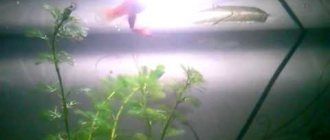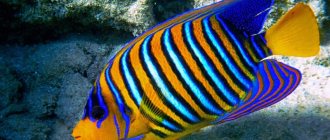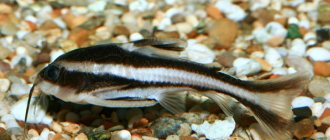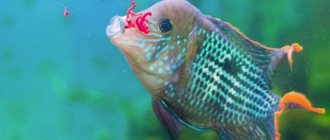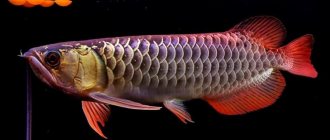Anyone who cannot afford to have a pet due to various circumstances, but really dreams about it, limits himself to aquarium fish. They do not need to be taken out for walks, trained to use a litter tray, or examined by a veterinarian, which means you can save a lot of time. In addition, people think that fish are much cheaper than a purebred dog or cat, although professional aquarists do not agree with this. There are some breeds for which you have to shell out tidy sums, since they are extremely rare in pet stores. We will tell you more about them.
Parrot fish
The parrotfish has a jaw shaped like a bird's beak. She gnaws coral reefs with her mouth.
These fish come in both aquarium and large specimens that grow up to two meters in length. They come in different colors - mostly bright tropical shades predominate.
Mastacembela
The family of proboscis snouts is rightfully considered one of the smallest, and mastacembelas are one of its brightest representatives. They live in natural reservoirs only in Southeast Asia and some regions of Africa. The fish has a serpentine body up to 700 millimeters long. The upper jaw of this representative of the family has a process similar to a short proboscis. The disadvantage of such fish is that they are rarely seen in public, as they prefer privacy. Most of the time they sit in shelters and are active at night. It is recommended to keep mastacembel in water with a high salt content.
These fish should be bred in aquariums with soft soil so that they can hide freely. Deprived of this opportunity, mastacembelas will be in a state of stress, which will lead to dire consequences. Representatives of this species are fed only with live food. You cannot keep proboscis snouts with small fish, as the latter will be eaten. The aquarium must be covered as these fish can escape.
Big Mouth
The second name for largemouth is pelican fish. It was given this name because its mouth stretches as much as the pouch at the bottom of a pelican's beak. The mouth of the largemouth is very large: it makes up 1/3 of the entire body of this amazing fish. Apart from the head, the rest of the body resembles that of an eel; it is just as long and narrow.
If the skull bones were complete, the pelican fish would not be able to swim under the weight of its own head. Wise nature provided for this moment, so the largemouth has a skeleton of deformed porous bones and lightweight cartilage. For added relief, it has no scales, swim bladder, ribs or caudal fin. In place of the lateral fins there are only small rudiments, so the speed at which it swims is very low.
Due to the huge size of its mouth, largemouth can swallow prey that is larger than itself. The stomach is also adapted to this, so it stretches to enormous volumes.
On the body and tail of the pelican fish there are special photophores - luminous spots found in deep-sea inhabitants. The largemouth feeds not only on large fish, but also on small fry and crustaceans that are found at such depths.
Macrognathus
These fish have long fins on their backs, which distinguishes them from other relatives. Velvety dots seem to be scattered along the fins, framed by golden rims. The body, which has a woody tint, has marble streaks. The fish's snout is pointed, with small antennae. Males have flat bellies, which is how they differ from their “wives.” Macrognathus has a calm character, which is why the fish get along well with their other tribesmen.
It is recommended to feed with tubifex. The recommended water temperature is 22-28 degrees. Hardness is not particularly important, but salt must be added to the water in the amount of three grams per liter. In captivity, macrognathus reproduce well, but for these purposes a separate container of 200 liters is required. Pets have to be stimulated to produce offspring using an artificial method - by administering hormonal injections. Although, as experts note, recently cases of spawning without human intervention have become more frequent.
Hypancistrus Zebra L046
Yes, personal number, everything is serious. A numbered catfish that lives in Brazil and has been so actively exported from Brazil that its export is prohibited. But the Russian craftsman cannot be stopped by such nonsense, and now the fry are on sale. No theft, no breeding!
In addition to coloring, there is also a suction cup instead of a mouth. Hypancistrus, despite the sucker, prefers live food, when, like other catfish, they feed by scraping all sorts of dirt from stones.
Exotic sea creatures
The depths of the sea are extremely rich in various exotic and rare species of fish. To date, no more than 20% of the World Ocean has been studied, so new deep-sea species are constantly being discovered, which amaze with their appearance, ability to live in complete darkness and under conditions of enormous pressure.
Ambona scorpion
This fish was discovered more than a century ago, but until now scientists have come across only a few specimens, on the basis of which this species was described.
Scorpionfish are excellent at camouflage
The characteristic features of the scorpionfish include:
- frequent shedding of the keratinized body;
- ability to change color;
- the presence of specific growths above the eyes;
- excellent camouflage abilities.
The Ambona scorpionfish prefers shallow depths and is found near southern coral reefs. Scorpion fish like to hunt at the very bottom, burrowing into fine sand, luring prey with flexible appendages near the mouth. The ambo scorpionfish prefers exclusively clean, warm water, so in recent years, due to the pollution of the World Ocean, the population of this fish has decreased significantly.
Sea sticktail
This is a rare deep-sea fish that has a unique body structure. The stick-tail has a huge mouth in the form of a tubular opening, and its jaws extend into an expanding leather pouch. Such a bag works on the principle of a blacksmith's bellows and is capable of expanding several times, which allows the sticktail to catch and digest prey that is several times its size.
The length of the deep-sea sticktail can reach 10 meters. Moreover, the length of the tail of this fish is 5-6 meters. The tail is extremely hard and long, and its structure has not yet been studied by scientists. This fish was discovered about 20 years ago, and during this time scientists came across only three specimens, which were already dead and in poor condition. But it has still not been possible to capture the behavior of a living sticktail on camera.
The tail can reach 6 meters
Psychedelic frog
This species of marine fish was discovered in 2009. The frogfish prefers great depths and has an unusual appearance that allows it to camouflage itself against the background of the bottom and corals. The head is large in size, with wide-set eyes. The coloring of the psychedelic frog is extremely interesting - with reddish and yellowish winding stripes that diverge from the eyes in different directions. The fins of the frog fish are modified and vaguely resemble the paws of land animals. Ichthyologists claim that this species is transitional between aquatic aquatic organisms and terrestrial animals.
Today, several color variations of this rare sea fish are known:
- Yellow uniform with turquoise eyes and white lines.
- Red variety with yellow stripes.
- A dark form that can change color to almost black.
Body color largely depends on the general color scheme of the environment. On dark soil and at great depths, black forms are found, but in shallow water in coral reefs you can simultaneously see yellow and red colors.
The frogfish prefers a bottom lifestyle and is found at depths of about 200−500 meters. Young specimens often stay in shallow water near coral reefs, however, as they mature, they move to greater depths and lead a pronounced predatory lifestyle. It has been established that the habitat of the frogfish is the waters of Australia, as well as the tropical region of the Indian Ocean.
This kind of fish lives in the depths
Fish rag picker
This species was discovered in 1865, but until now scientists have come across only a few dozen specimens of these fish, which is explained by their secretive lifestyle and strictly limited habitat. This species is notable for the fact that its entire body, fins, tail and head are covered with processes that imitate various algae. Such processes perfectly camouflage ragpickers during their hunt for shrimp and other crustaceans.
The rag picker's habitat is the Indian Ocean and the southeast coast of Australia. The fish leads a hidden lifestyle, preferring clean and warm coastal waters, hiding in corals during the day and going hunting for small plankton and crustaceans at night.
There are branches all over the body
Moonfish
This species was discovered back in the 18th century, when this fish was found everywhere. Today, with the pollution of the World Ocean and active fishing, sunfish are becoming increasingly rare. This species is large in size and has a tall, short, laterally compressed body. The sunfish can reach gigantic sizes with a body diameter of tens of meters and a weight of up to one and a half tons. Adults feed on jellyfish, eels, squid and various plankton. The moonfish is a poor swimmer, so it does not like strong currents, and often simply lies on the very surface of the water surface.
This fish does not like current
Broad-nosed chimera
The broad-nosed chimera prefers the depths of the Atlantic Ocean, where it feeds on a variety of mollusks. To date, scientists have come across only a few specimens of this extremely rare fish. Its peculiarity is its jelly-like body, which, when raised to the surface, quickly dissolves into the chimera's bony skeleton.
The difficulty of studying this species is explained by its way of life, when the chimera practically does not appear at depths less than 1000 meters. Only with the development of special technology were scientists able to see it in its natural environment at depths of more than one and a half thousand meters.
Chimera does not appear below 1000 meters
Frilled shark
This species of deep-sea shark was discovered in 1884. In appearance, adult individuals more closely resemble an eel or a strange sea snake. The gill openings, of which there are 6 on each side of the body, are covered with skin folds. Membranes and gill slits are also found in the shark's throat, connecting into a wide leathery blade. This is one of the rarest species of sharks, found only at great depths. To date, the frilled shark has been poorly studied, and in total, scientists have come across about 100 specimens of this rare species of predator.
This is a type of shark
Indonesian coelacanth
The Indonesian coelacanth was discovered in 1999. This fish belongs to the coelant family and is the oldest described aquatic organism on earth. Previously, it was believed that all representatives of the coelant order became extinct before the appearance of dinosaurs. Studies have shown that this species appeared approximately 40 million years ago.
To date, no more than a dozen specimens of Indonesian coelacanth have been caught. Coelacanth has a strange body shape with modified lower fins that vaguely resemble the limbs of ancient fossils. The internal structure of coelacanth is extremely unusual - something between the structure of land animals and classic fish.
One of the oldest types
Hairy monkfish
These fish, scary and strange in their behavior, were discovered in 1930. The hairy sea devil prefers great depths of over 1 kilometer. In such water there is pitch darkness, which is what the devil, who has a luminous appendage on his forehead, takes advantage of. With the help of such a device, the hairy devil attracts crustaceans and other fish, which become victims of this predator.
The method of reproduction of this fish is extremely interesting. Female monkfish measure about a meter and weigh 15-20 kilograms. The male is usually ten times smaller than the females; he simply attaches himself to the body of his chosen one, after which sperm constantly enter the female’s body through the blood. For the rest of his life, the male receives all the nutrients he needs from the huge predator. On one large female you can find several males attached to her at once, which can live like this until their death.
Tetraodon dwarf
Have you ever seen an optimist fish? If not, then look at Tetraodon. The expression on his face is always ironic, and his eyes run back and forth, back and forth. Aquarists who keep such fish say that it’s hard to imagine more interesting representatives of the home underwater world! And this, despite the fact that tetradon is a close relative of fugu fish - the same one that, if improperly prepared, can cause death.
Such fish have a small body, but under certain circumstances they swell, turning into a ball. They do this so that predatory neighbors cannot dine on them. Tetraodons have a capricious character: they do not obey the laws established in the aquarium community, and behave completely independently and even brazenly. These babies tear off the fins of other fish and, without chewing, swallow them. Tetraodon teeth grow permanently throughout their lives, so they need to be given something hard to chew on, such as snails.
Arowana silver
These fish do not have a bright color, however, they are able to decorate any aquarium, as they look like thin silver ingots. They represent the family of bone tongues, have a color corresponding to their name, and an elongated and laterally flattened body. The head and mouth of the arowana are quite large, which is especially noticeable when the fish opens its mouth to swallow food. In natural bodies of water, such fish are usually grouped near the shore, as they feed on insects and fry that fall into the water. The body length of adult fish is about 500 millimeters.
Arowanas live a long time, have a friendly character, are able to recognize their owner and love to be fed by hand. Offer them shellfish, worms, insects and fish meat. All food must be waterfowl. By the way, based on their own observations, aquarists have come to the conclusion that keeping an arowana brings happiness and good luck to the house. In this sense, representatives of this species can be compared to the well-known goldfish.
glass perch
In the reservoirs of India, Burma and Thailand, these fish are often found, but in our country they are extremely rarely sold in stores. Glass perch has a transparent, laterally flattened body, reaching a length of 40 millimeters. Even through the walls of the aquarium, the internal organs and skeleton of the perch are clearly visible, which is why it received such an original name. Females differ from males because their air bladder is round. Males turn golden when exposed to light.
If you want to have such fish, then the water in your aquarium should have average hydrochemical parameters. This species requires bright lighting combined with dark soil. There should be a lot of vegetation in the container. It is recommended to feed bloodworms and enhintrea. The glass perch has a peaceful character, thanks to which it gets along well with its non-predatory neighbors, however, experts advise keeping it in a separate aquarium, since in this case it will be more interesting to watch. Males divide the territory among themselves, after which they invite their “brides” to it to reproduce offspring. This behavior eliminates conflicts between fish and eating fry. By the way, the younger generation is very picky in their diet: they require a certain type of algae.


